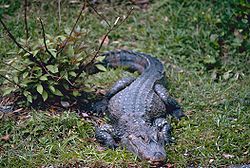- Chinese alligator
-
Chinese Alligator 
Conservation status Scientific classification Kingdom: Animalia Phylum: Chordata Class: Reptilia Order: Crocodilia Family: Alligatoridae Genus: Alligator Species: A. sinensis Binomial name Alligator sinensis
Fauvel, 1879
Synonyms - Caigator sinensis Deraniyagala, 1947
The Chinese alligator or Alligator (simplified Chinese: 扬子鳄; traditional Chinese: 揚子鱷, (yáng zǐ è) Alligator sinensis) is one of two known living species of Alligator, a genus in the family Alligatoridae. The Chinese alligator is native only to China. It is smaller than the other alligator species, the American alligator, growing to an average of 1.5 m (5 ft).
Contents
Appearance
While its appearance is very similar to the only other living member of the genus, the American alligator, there are a few differences. One obvious difference is that the Chinese alligator is quite small. Usually only attaining a length of 5 feet (1.5 m), these alligators are known to grow to 7 feet (2.1 m), though that was not officially announced until recently.[citation needed] Unlike the American alligator, the Chinese alligator is fully armored; even the belly is armored, which is a feature of only a few crocodilians. They weigh up to 100 pounds (45 kg). Chinese alligators grow slowly, being only 2 ft (60 cm) long after 2 years of age.[citation needed]
Geographic range and habitat
While it originally ranged through much of China, this species' wild habitat has been reduced to little more than a few ponds containing a small number of animals (fewer than 200 individuals, only approximately 50 of which are mature) along the lower Yangtze River in the provinces of Jiangsu, Zhejiang, and Anhui. Its population reduction has been mostly due to conversion of its habitat to agricultural use. A majority of their usual wetland habitats have been turned into rice paddies.[1] Poisoning of rats, which the alligators then eat, has also been blamed for their decline. In the past decade, very few wild nests have been found, and even fewer produced viable offspring.
Conservation status
The Chinese alligator is listed as a CITES Appendix I species, which puts extreme restrictions on its trade and exportation throughout the world. It is IUCN Red Listed as a critically endangered species. Efforts are underway to reintroduce captive-bred animals to suitable wild habitats, but thus far have not met with much success.
In captivity
Chinese alligators are quite prolific in captivity, with estimates of the total captive population at over 10,000 animals, mostly in the Anhui Research Centre of Chinese Alligator Reproduction and the Madras Crocodile Bank, as well as in numerous zoos, including the St. Augustine Alligator Farm Zoological Park which has successfully bred the Chinese alligator and has been fortunate enough to release some of the offspring back into the wild in China. They can also be seen in the reptile houses of the Cincinnati Zoo, Memphis Zoo, and St. Louis Zoo.[2] In an effort to ensure the species' survival, Chinese alligators hatched at zoos in the United States are being reintroduced into the wild in China.[3]
In several restaurants and food centres in China's booming areas, young and premature alligators are allowed to roam free with their mouths taped shut.[4] They are subsequently killed for human consumption, as in China alligator meat is thought to cure colds and prevent cancer.[4] In China the organs of the Chinese Alligator are sold as cures for a number of ailments.[1] This species is widely regarded as quite docile, but, as with any crocodilian, it is capable of inflicting grievous bodily harm.
Cultural influence
Martial arts
A rare alligator form exists in the cadre of animal forms belonging to Xingyiquan boxing.[5] One source states this technique was inspired by the way an alligator can "float and swim well".[6] It goes on to say "The alligator’s attribute is a combination of quietness, nimbleness, and a sudden, smooth, and quickly twisting force."[6] The character used to represent alligator in this instance is Tuo (simplified Chinese: 鼍; traditional Chinese: 鼉),[6] which is different from the character regularly used to describe both the alligator and crocodile. Tuo is generally used to describe any number of large reptiles or water lizards.[7]
See also
References
- ^ a b www.flmnh.ufl.edu
- ^ http://www.stlzoo.org/animals/abouttheanimals/reptiles/alligatorsandcrocodiles/chinesealligator.htm
- ^ www.cincinnatizoo.org
- ^ a b Chang, L. T., and Olson, R.. Gilded Age, Gilded Cage. National Geographic Magazine, May 2008.
- ^ Xing Yi Chuan
- ^ a b c Shengli, Lu. Combat Techniques of Taiji, Xingyi, and Bagua: Principles and Practices of Internal Martial Arts. Berkeley, Calif: Blue Snake, 2006 (ISBN 1583941452)
- ^ Tuo definition
- The Chinese Alligator: Ecology, Behavior, Conservation, and Culture. John Thorbjarnarson and Xiaoming Wang. 2010. Johns Hopkins University Press. ISBN 0-8018-9348-8
- Crocodile Specialist Group (1996). Alligator sinensis. 2006. IUCN Red List of Threatened Species. IUCN 2006. www.iucnredlist.org. Retrieved on 11 May 2006. Listed as Critically Endangered (CR A1c, D v2.3)
- Crocodilian Species - Chinese Alligator
- IUCN Red List of Threatened Species: Alligator sinensis
- Species Alligator sinensis at The Reptile Database
External links
Extant Crocodilian species Kingdom: Animalia · Phylum: Chordata · Class: Sauropsida · (unranked): Archosauria · Superorder: CrocodylomorphaFamily Gavialidae Family Alligatoridae Alligatorinae
(Alligators)American alligator (A. mississippiensis) · Chinese alligator (A. sinensis)Caimaninae
(Caimans)Related articles on alligators, caimans, crocodiles and gharials Topics Human
interactionU.S. Alligator fatalities · Crocodile attacks · Alligator farm · Crocodile tears · Famous crocodiles and alligators · Sewer alligatorCategories:- IUCN Red List critically endangered species
- Reptiles of China
- Megafauna of Eurasia
- Alligatoridae
- Animals described in 1879
Wikimedia Foundation. 2010.

